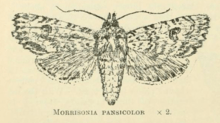George Howes (entomologist)
William George Howes (4 December 1879 – 20 February 1946) was a New Zealand entomologist and businessman.
William George Howes | |
|---|---|
 | |
| Born | 4 December 1879[1] Southbridge, Canterbury |
| Died | 20 February 1946 (aged 66) |
| Resting place | Andersons Bay Cemetery, Dunedin. Block 114. Plot 66 |
| Nationality | New Zealander |
| Citizenship | New Zealand |
| Scientific career | |
| Fields | Entomology |
| Institutions | G. Howes and Co.; University of Otago |
| Author abbrev. (zoology) | Howes |
Early life
Howes was born in 1879 at Southbridge. He was one of five surviving children of Cecilia Brown and William Howes, a post office clerk and accountant from England. His elder sister Edith, who would become a writer and educationalist, was born in 1872 before the family migrated to New Zealand.[2]
Career
Howes authored scientific papers on entomology, concentrating on New Zealand Lepidoptera, and described numerous species new to science.[3] The species Molophilus howesi was named in his honour.[4]
Howes was a member of a number of organisations including the Royal Entomological Society, Linnean Society of London, American Entomological Society, the Otago Chamber of Commerce, New Zealand Institute, Otago Acclimatisation Society where he sat on the council, and the Dunedin Naturalists Field Club for which he was president for many years.[5] For a quarter of a century, Howes was one of the directors of the Portobello Marine Biological Station.[6]
Due to his acknowledged entomological expertise, Howes was invited to be part of a scientific expedition to the Chatham Islands in 1924.[7][8]
Howes was involved in the planning, establishment and management of the aquarium at the New Zealand and South Seas International Exhibition in 1925 on Logan Park, Dunedin. When this was unable to be funded by the Acclimatisation Society or the City Corporation, Howes and others registered a private company Aquarium Ltd "to carry on the business of an aquarium at the New Zealand and South Seas Exhibition at Dunedin."[9]
Death
Howes died suddenly on 20 February 1946 at Dunedin where he had lived most of his life. He was buried at Andersons Bay Cemetery. He was survived by his wife Beatrice and four children.[6]
Gallery
 Argyrophenga antipodum
Argyrophenga antipodum Chrysophanus boldenarum
Chrysophanus boldenarum Chrysophanus sallustrius
Chrysophanus sallustrius Dasyuris transaureus
Dasyuris transaureus Larentia cinnabari
Larentia cinnabari Morrisonia mollis
Morrisonia mollis Morrisonia pansicolor
Morrisonia pansicolor Morrisonia pascoei
Morrisonia pascoei Morrisonia sequens
Morrisonia sequens
References
- Birth certificate registration number 1880/1517; Department of Internal Affairs
- Murray, Heather. "Howes, Edith Annie". Dictionary of New Zealand Biography. Ministry for Culture and Heritage. Retrieved 6 April 2019.
- Miller, David (1946). "Obituary. William George Howes (1879–1946)". Transactions and Proceedings of the Royal Society of New Zealand. 76 (2): 262–263. Retrieved 6 July 2017.
- Alexander, Charles P. (1923). "XVII. New or little-known Tipulidae (Diptera). XIV. Australisian Species". The Annals and Magazine of Natural History. 9th ser. v. 11: 193–208. ISSN 0374-5481.
- Salmon, J.T. (1975). "W.G.Howes (1879–1946)". N.Z. Nat. Heritage. 6 (78): Back Cover. Retrieved 5 March 2019.
- "Obituary". Evening Star (25723). 21 February 1946. p. 4. Retrieved 5 April 2019.
- "The Chatham Islands". Otago Daily Times (19076). 23 January 1924. p. 6. Retrieved 5 March 2019.
- "Chatham Islands Expedition". Evening Star (18558). 14 February 1924. p. 10. Retrieved 5 March 2019.
- "Commercial". Otago Daily Times (19447). 4 April 1925. p. 8. Retrieved 5 March 2019.
External links
- Record of William George Howes in Collections Online, Museum of New Zealand Te Papa Tongarewa
- Howes W.G. and W.W. Smith, “Notes on Sphaeria larvarum, Westw.,” Entomologist. Vol. 31. 1898: 128–39
- Howes, W. G. "On the occurrence of M. strategica in Invercargill."Transactions of the New Zealand Institute. Vol. 33. 1901.
- Howes, G. Note on the Occurrence of Two Rare and Two Introduced Moths. Transactions and Proceedings of the Royal Society of New Zealand. Volume 38, 1905
- Howes, W. G. "Some new species of Lepidoptera." Transactions and Proceedings of the New Zealand Institute. Vol. 38. 1906.
- Howes, George. Further Notes on Lepidoptera. Transactions and Proceedings of the Royal Society of New Zealand. Volume 40, 1907.
- Howes, W. G. "New species of Lepidoptera." Transactions and Proceedings of the New Zealand Institute. Vol. 43. 1910.
- Howes, G. Notes on the Vegetable Caterpillar. Transactions and Proceedings of the Royal Society of New Zealand Volume 43, 1910.
- Howes, W. G. "New species of Lepidoptera, with notes on the larvae and pupae of some New Zealand butterflies." Transactions and Proceedings of the New Zealand Institute. Vol. 44. 1911.
- Howes, W. G. "Notes on the Entomology of Stewart Island." Transactions and Proceedings of the New Zealand Institute. Vol. 46. 1913.
- Howes, W. G. Notes on the Life-history of some New Zealand Moths” Transactions and Proceedings of the Royal Society of New Zealand. Vol. 46. 1913.
- Howes, W. George. New Lepidoptera. Transactions and Proceedings of the Royal Society of New Zealand. Vol. 46. 1913.
- Howes, W.G. New Lepidoptera. Transactions and Proceedings of the Royal Society of New Zealand. Volume 49, 1916.
- Howes, W. George. "New Lepidoptera." Transactions and Proceedings of the Royal Society of New Zealand. Vol. 71. 1942.
- Howes, W. George. "Lepidoptera Collecting at the Homer'." Transactions and Proceedings of the Royal Society of New Zealand. Vol.73. 1943–1944.
- Howes, W. George. New Lepidoptera. Transactions and Proceedings of the Royal Society of New Zealand. Volume 75, 1945–46.
- Howes, W. George. "Lepicjoptera Collecting at the Homer, with Descriptions of New Species." Transactions and Proceedings of the Royal Society of New Zealand. Vol. 76, 1946–1947.